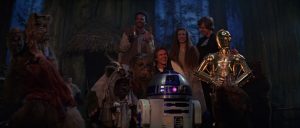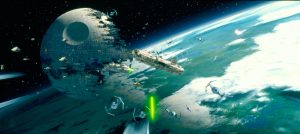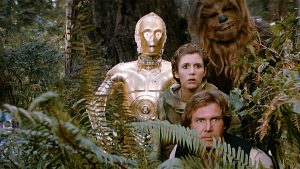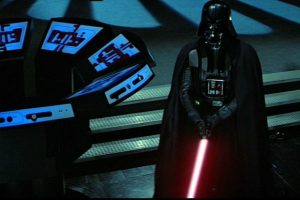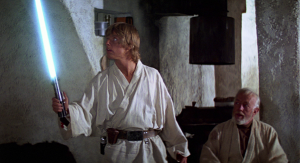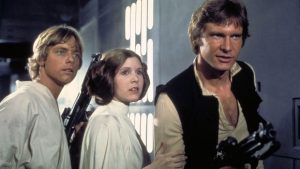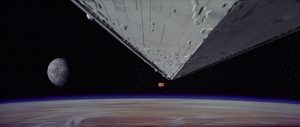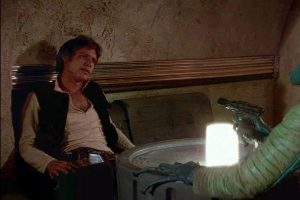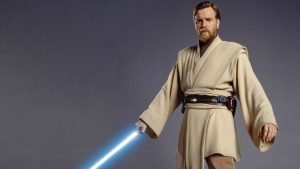We are officially in the last leg of the long journey to Star Wars: The Rise Of Skywalker, which means that the mighty Skywalker Saga, a story spanning forty years across films, books, comics, cartoons and video games is finally coming to a close – which in turn means that it’s time to reflect on that nine-part saga and take a good long look at the films that predate and inform Rise Of Skywalker‘s epic conclusion.
To do that, we’re going to have to discuss spoilers for each of the eight films in the Saga, so…SPOILERS AHEAD.
Star Wars: The Phantom Menace
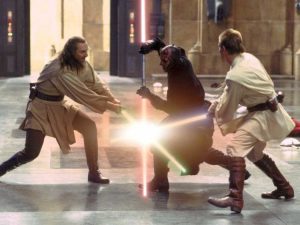
It’s finally time to explain my decision not to start my eight-part review of the Star Wars franchise with what is now technically referred to as the first movie. The idea of having to wade, Gungan-style, through three intermittently bad movies before getting to the series’ real gems was simply not appealing to me, so I took what we’ll call a detour – by going through the films in the order of release, rather than where they fall in the official timeline. But, of course, destiny arrives regardless, and now we have finally set foot on the soggy, pleasantly pastel planet where humans and sentient dinosaurs live together in harmony among a picturesque landscape of waterfalls, rainforests and Renaissance cities…yes, it’s Dinotopia.
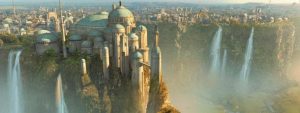
No, wait, that’s not right. Sorry, it’s Dinotopia’s identical twin, Naboo.
Here, amid all that lush greenery and damp air, our story begins: it is the story of a boy who would become a man who would become a machine, a child born into the world to serve a dark power’s nefarious purposes, a Jedi who would turn to the Dark Side of the Force and join the ranks of the Sith. Here, on the planet Naboo, begins the story of Anakin Skywalker.
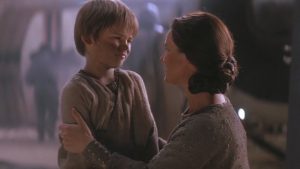
Wait, that’s not right either. Anakin’s story doesn’t start here. So then…why does the movie start here?
Unfortunately, there’s no good answer to that question, which lingers over the whole prequel trilogy. The point of the prequels was supposedly to go deep into the psyche of the man who became Darth Vader, to discover what went so horribly wrong in his life that he would turn away from the light and succumb to darkness. And yet somewhere along the way, director George Lucas realized that he actually wanted to make an entire movie about intergalactic politics and shipping blockades – and, uh, sure that has something to do with Anakin Skywalker’s journey to the Dark Side! How? Well…because Padmé Amidala, Anakin’s wife, came from Naboo, that’s how. And so the story of Anakin Skywalker actually begins with Padmé, the young, seemingly naive Queen of the Naboo people, being rescued from her home planet by the Jedi and…wait, you’re telling me we spend the first half-hour of the movie on a rescue mission to free Padmé only to find out in the film’s last thirty-five minutes that it’s not even the real Padmé?
This is, unfortunately, only one example of the problem with the prequel trilogy, but it highlights one of Phantom Menace‘s biggest structural flaws. Rather than focusing on the character of Anakin Skywalker (who was likable enough here, portrayed by Jake Lloyd), the movie wastes valuable screentime on supporting characters and three or four different political subplots that have no bearing on Anakin’s story whatsoever. This epic failure is comparable to Fantastic Beasts: The Crimes Of Grindelwald, a movie in which plot took precedence over character development, to the detriment of both – a huge, complex plot means nothing if there aren’t sturdy, strong characters to hoist it on their shoulders when the going gets rough and carry the audience’s interest across the finish line. In both Crimes Of Grindelwald and Phantom Menace, the “characters” are mostly cardboard cutouts barely capable of carrying a single scene, much less an entire movie.

There’s a trio central to the story of Phantom Menace, but it’s sometimes hard to tell whether it consists of Anakin Skywalker, Padmé Amidala (Natalie Portman), and Obi-Wan Kenobi (Ewan McGregor) or Anakin, Padmé and Qui-Gon Jinn (Liam Neeson). Obi-Wan is the more important of the two in the long run, but he does virtually nothing in Phantom Menace except stand by Qui-Gon’s side and argue with him about whether or not Anakin should be trained as a Jedi. And then at the very end of the movie, he gets to kill the Sith apprentice Darth Maul in one epic lightsaber fight that makes his earlier irrelevance not only confusing but frustrating. As previously mentioned, Padmé is actually disguised as a different character for most of the film, while Sabé (Keira Knightley) wears her identity. Anakin isn’t in the movie’s first half-hour, and even when he does show up, he’s still initially a supporting character – at best, he’s a walking plot device until he takes command of his very own starship in the finale. Until the second film, I think it’s safe to say that most of this defining chapter in Anakin’s life is told from the viewpoint of Qui-Gon Jinn as he tries, unsuccessfully, to decipher the child’s parentage and account for his abnormally high midi-chlorian count (yes, this film also establishes that your strength in the Force is determined by the amount of alien blood-cells living in your body, which just…no).
And it’s not like anybody else ever figures out what Anakin is, either. Even to this day, Star Wars canon is conflicted about where he came from – the predominant theory being that he was “conceived by the midi-chlorians”, meaning that, in essence, he’s the son of the Force itself. That’s all well and good, but why wasn’t it ever explained in the movie? The only hint we get about his parentage is one vague quote from his mother, Shmi (Pernilla August), who tells Qui-Gon that “There was no father. I carried him, I gave birth, I raised him, I can’t explain what happened.” Yeah, well, try. Any explanation would be better than simply giving us yet another unanswered question about the character whose backstory we were supposed to be learning!
I think that, even without making the movie about Anakin (since George Lucas was clearly resistant to that idea, for whatever reason), a compelling story could still have been told – if the actual focus hadn’t instead been directed on the impossibly complicated political system of Naboo, and their relations with the Gungan aliens, Viceroy Gunray’s Trade Federation and the Old Republic’s corrupt, bureaucratic system. Now, I love political intrigue: it’s one of my favorite tropes in sci-fi, fantasy or fiction in general. But intrigue has to revolve around character in order to work properly – simply having shipping blockades and assassination attempts and coups isn’t interesting, unless we care about the characters that these things are happening to: for instance, look at Game Of Thrones, which, in its first few seasons, expertly handled political intrigue by pitting fleshed-out characters against each other in interesting ways and giving them real motivations and agendas that audiences could become invested in. It’s hard to become invested in Naboo’s fight for independence when we know next to nothing about the handful of characters in the movie who actually hail from Naboo – especially when one of them is Jar-Jar Binks (Ahmed Best).
Now, I just want to preface this by saying that I bear no ill-will towards Ahmed Best, who was simply doing his job and the best that he could in extremely difficult circumstances: I wish him well, and I’m very glad to hear that he’s just landed a role as the host of a Star Wars game show on Disney+. That’s fantastic. But the character he happens to portray, the notorious alien by the name of Binks, is without a doubt the most pointless and pathetic character in the Star Wars universe – and it’s a big universe. But between his…jokes?…and his voice, and his unnervingly long tongue, there is not a single thing about Jar-Jar that helps the prequel trilogy in any way. Worse, he’s actually damaged the trilogy’s reputation.
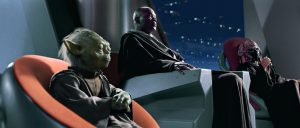
On the other side of the galaxy but almost as useless, the Jedi Order loses all of its mystique and magic when glimpsed in The Phantom Menace, where they’re basically just a group of squabbling elders blind to the disintegration of the society they’re sworn to protect. Seeing them here, at what was apparently the height of their glory, it’s hard to imagine they stayed in business as long as they did. It’s even harder to imagine that they could ever be brought back, or that they would be effective, if they were.
The Sith, however, have never looked so appealing as they did here, operating in secret from behind thrones and senate-seats across the galaxy, a cult based on the duality of master and apprentice. While the master himself, Chancellor Palpatine a.k.a. Darth Sidious (Ian McDiarmid) is busy getting “elected” to ever-loftier positions of power in the New Republic, his apprentice Darth Maul (Ray Park) is on assignment like a mysterious ninja, or a ghostly assassin, or a…phantom menace. While Maul would look cool regardless of his weaponry (dude’s literally a six-foot tall Dathomirian Dark Lord covered in horns and red-and-black full-body tattoos), having a freaky, double-bladed lightsaber probably doesn’t hurt his image. Sadly, while he was undeniably one of the Dark Side’s most photogenic champions (in the days before Kylo Ren), he was cut in half by Obi-Wan Kenobi at the end of the movie, preventing him from ever realizing his true potential. One thing that can be said of the prequel trilogy is that it had some epic villains – it just didn’t keep them around long enough to make much of a difference.
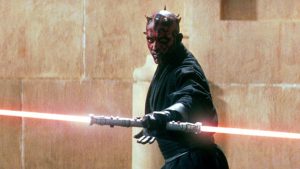
And that’s the biggest problem with The Phantom Menace: huge potential, but nothing to do with it. It’s a movie that spends more time explaining the mechanics of pod-racing and the structure of the intergalactic Senate than the dynamics of its core cast of characters, or the psychology of our protagonist…who, as time goes by, becomes only more distanced from the audience, because he was never close to us to begin with.
Movie Rating: 4.9/10
